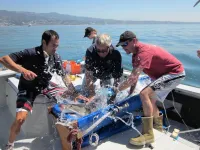(Press-News.org) New research led by Monterey Bay Aquarium reveals that even the revered white shark cannot escape the impacts of a changing ocean. The study, published in Scientific Reports, finds that unprecedented sightings of juvenile white sharks at the northern end of Monterey Bay signal a significant shift in the young white sharks' range.
Researchers conclude the northward range shift demonstrates the young sharks are being subjected to a loss of suitable thermal habitat, meaning water temperatures within their preferred temperature range are becoming harder to find.
"Nature has many ways to tell us the status quo is being disrupted, but it's up to us to listen," said Monterey Bay Aquarium Chief Scientist Dr. Kyle Van Houtan. "These sharks - by venturing into territory where they have not historically been found - are telling us how the ocean is being affected by climate change."
Aquarium scientists and their research partners began using electronic tags to learn about juvenile white sharks in southern California two decades ago when they were preparing to display the young white sharks to the public.
When the dramatic North Pacific marine heatwave hit the California coast between 2014-2016, these same researchers started to notice uncharacteristic sightings of juvenile white sharks in nearshore, central California waters near Aptos, California. This is farther north than young white sharks have ever been seen before as the animals historically remain in warmer waters in the southern California Current.
Water temperature in the Aptos area averages about 55 degrees Fahrenheit (13 degrees Celsius), but temperature extremes have become more common since the heatwave hit, rising as high as 69 degrees Fahrenheit (21 degrees Celsius) in August 2020.
Scientists conducted the research by collecting data from tags the Aquarium and its partners deployed on juvenile white sharks beginning in 2002 to see where the animals were spending most of their time.
The team analyzed 22 million electronic data records from 14 sharks and then compared these data to 38 years of ocean temperatures to map the cold edge of the animals' thermal preferences, or "niche."
The study charts the significant northward shift in the young white sharks' range.
Between 1982 and 2013, the northernmost edge of the juveniles' range was located near Santa Barbara (34° N). But after the marine heatwave, their range shifted dramatically north to Bodega Bay (38.5° N). Ever since, the young sharks' range limit has hovered near Monterey (36° N).
"After studying juvenile white shark behavior and movements in southern California for the last 16 years, it is very interesting to see this northerly shift in nursery habitat use," said Dr. Chris Lowe, a co-author of the study and director of the Shark Lab at California State University, Long Beach. "I think this is what many biologists have expected to see as the result of climate change and rising ocean temperatures. Frankly, I'll be surprised if we don't see this northerly shift across more species."
Because this shift took scientists by surprise, the team turned to novel sources of data such as community science and recreational fishing records to document this northward movement of the population.
"This study would not have been possible without contributions from our community scientists and treasured Aquarium volunteers," says Dr. Van Houtan. "Eric Mailander, a local firefighter, provided a decade of detailed logbook records of shark sightings, and volunteer Carol Galginaitis transcribed those hand-written data into an electronic database."
The researchers say this study reinforces what scientists have been saying for years: animals and the living world are revealing the impacts of climate change.
"White sharks, otters, kelp, lobsters, corals, redwoods, monarch butterflies - these are all showing us that climate change is happening right here in our backyard," says Dr. Van Houtan. "It's time for us to take notice and listen to this chorus from nature. We know that greenhouse gas emissions are rapidly disrupting our climate and this is taking hold in many ways. Our study showed one example of juvenile white sharks appearing in Monterey Bay. But let's be clear: The sharks are not the problem. Our emissions are the problem. We need to act on climate change and reduce our reliance on fossil fuels."
INFORMATION:
About Monterey Bay Aquarium
With a mission to inspire conservation of the ocean, the Monterey Bay Aquarium is the most admired aquarium in the United States, a leader in science education, and a voice for ocean conservation through comprehensive programs in marine science and public policy. Everything we do works in concert to protect the future of our blue planet. More information at MontereyBayAquarium.org.
Our consumer products, such as food, cosmetics and clothes, might be filled with nanomaterials - unbeknownst to us. The use of nanomaterials remains unregulated and they do not show up in lists of ingredients. This is a cause of concern since nanomaterials can be more dangerous than COVID-19 in the long term if no safety action is taken: they are tricky to measure, they enter our food chain and, most alarmingly, they can penetrate cells and accumulate in our organs.
Nanotechnology is appearing everywhere, to change our daily lives. Thanks to applications of nanotechnology, we can treat many diseases so efficiently that they'll soon be a thing of the past. We also have materials that are 100 times stronger than steel, batteries that last 10 times longer than ...
The term plankton describes usually very small organisms that drift with the currents in the seas and oceans. Despite their small size, they play an important role for our planet due to their immense quantity. Photosynthesizing plankton, known as phytoplankton, for example, produce half of the oxygen in the atmosphere while binding huge amounts of carbon dioxide (CO2). Since the Southern Ocean around Antarctica is very rich in nutrients, phytoplankton can thrive there. It is therefore a key region for controlling atmospheric CO2 concentrations.
As other nutrients are abundant, scientists have ...
Exposure to radiation can wreak indiscriminate havoc on cells, tissues, and organs. Curiously, however, some tissues are more vulnerable to radiation damage than others.
Scientists have known these differences involve the protein p53, a well-studied tumor-suppressor protein that initiates a cell's auto-destruct programs. Yet, levels of this sentinel protein are often similar in tissues with vastly different sensitivities to radiation, posing the question: How is p53 involved?
A new study by researchers in the Blavatnik Institute at Harvard Medical School, Massachusetts General Hospital, and the Novartis Institutes for BioMedical Research now sheds light on this mystery.
Reporting in Nature Communications on Feb. 9, they describe how cellular survival after radiation exposure depends ...
What is the best way to monitor a brain tumor? This question is at the heart of a new Position Statement published in open-access journal Frontiers in Oncology. The article is the work of a large collaboration of UK experts and stakeholders who met to discuss the value of routinely imaging brain tumor patients to assess their tumor treatment response, which is known as "interval imaging". Their verdict: there is very limited evidence to support the practice at present. However, the article also discusses how future research could determine and maximize the value of interval ...
A new study in Frontiers in Communication has demonstrated the powerful impact that subtle messaging and cues, or 'nudges', can provide on encouraging people to show socially desirable behaviors. Travelers who were observed on the Indonesian island of Gili Trawangan, a popular tourist destination, were more likely to demonstrate environmentally conscious actions, such as refusing a plastic bag or avoiding contact with a coral reef, when they were 'nudged' towards the desirable action with either a written or face to face interaction. The researchers found that any intervention, whether framed positively or negatively, was ...
Asthma attack rates seen at GP surgeries fell significantly during the first Covid-19 pandemic lockdown of 2020, a study suggests.
Lower levels of air pollution, fewer cold and flu infections, and the fear of attending doctor surgeries due to Covid-19 were possible reasons for the 20pc drop in cases seen at GP surgeries, researchers said.
The study is the first national review of lockdown effects on asthma attacks and includes data from more than 100,000 patients.
Asthma attacks - or exacerbations - are bouts of shortness of breath, wheezing or a tight chest. There are usually more than six million GP consultations and 1400 deaths attributed to asthma in the UK every year.
For the study researchers from the University of Edinburgh looked at a national GP database ...
Higher excess COVID-19 death risk in middle-aged people with type 2 diabetes raises vaccine prioritisation questions
A largescale analysis led by the University of Exeter and funded by Diabetes UK, has found a disproportionately higher COVID-19 death risk in middle-aged people with type 2 diabetes, raising questions over vaccination strategies across Europe.
The study, accepted for publication in Diabetologia, found that compared to people of a similar age without type 2 diabetes, the additional COVID-19 mortality risk from having type 2 diabetes increases the younger someone is. Although the ...
Children aged between 5 months and 4 years attending daycare during lockdown in March to May 2020 in France had low rates of SARS-CoV-2 antibodies in their blood - known as seroprevalence - suggesting that virus infection rates were low in this population.
Research assessing seroprevalence in daycare centres that remained open during the first national lockdown in France, suggests that the rate of SARS-CoV-2 virus infection was low at 3.7%, with positive cases likely infected by an adult in their household, rather than whilst at daycare. The seroprevalence rate among daycare staff was similar to that of a control group of adults who were not exposed to children or COVID positive patients ...
In the event of a pandemic, delayed reactions and a decentralized approach by the authorities at the start of a follow-up wave can lead to longer-lasting, more severe and more fatal consequences, researchers from the universities of Zurich and Toronto have found. The interdisciplinary team compared the Spanish flu of 1918 and 1919 in the Canton of Bern with the coronavirus pandemic of 2020.
The Spanish flu was the greatest demographic catastrophe in Switzerland's recent history, causing approximately 25,000 deaths in the country during 1918 and 1919. In the wake of the current coronavirus pandemic, there has been increased public and scientific interest in the events of that time. An interdisciplinary team of researchers in evolutionary medicine, history, geography and ...
Oakland, Calif. -- An analysis of Kaiser Permanente members in Northern California early in the COVID-19 pandemic found racial and ethnic disparities in the likelihood of testing positive for the coronavirus, but no significant disparities in mortality among those who were hospitalized.
According to the study published Feb. 8 in Annals of Internal Medicine, Latino patients were nearly 4 times as likely as white patients to become infected with the virus, while Asian and Black patients were 2 times as likely to get COVID-19 as white patients. The odds of hospitalization were also higher for Latino, Asian, and Black patients with ...




